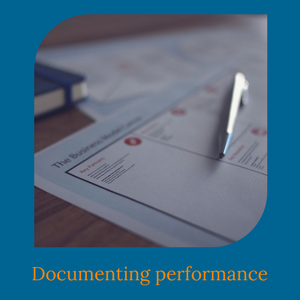 As an HR Director, it is not unusual for one of my first conversations with a new client to be about problems they are experiencing in managing the performance of an employee. It is also not unusual to hear that there have been many previous conversations with the employee that have had no effect and now is the time to take it to the formal process, but there is no documented evidence to prove this is the case. Why is this important? Well if the mantra of an estate agent is location, location, location, the mantra of a good HR professional should be documentation, documentation, documentation! Let’s talk about why.
As an HR Director, it is not unusual for one of my first conversations with a new client to be about problems they are experiencing in managing the performance of an employee. It is also not unusual to hear that there have been many previous conversations with the employee that have had no effect and now is the time to take it to the formal process, but there is no documented evidence to prove this is the case. Why is this important? Well if the mantra of an estate agent is location, location, location, the mantra of a good HR professional should be documentation, documentation, documentation! Let’s talk about why.
Why document an employee’s performance?
Throughout the life cycle of any employee it is essential to document their performance. This can be done through appraisals and one-to-one meetings with their line manager.
Setting clear goals and objectives will enable the employee to meet expectations and drive their performance. Both the employee and their manager will have a clear understanding of expectations and how these should be met and managed.
If there is a problem with someone’s performance then flags will be raised in the early stages, rather than letting performance issues slide and escalate in to a bigger problem. Managers can offer solutions, guidance and mentoring to help improve an employee’s performance.
Having good documentation will provide evidence that performance issues were raised and discussed with an employee in a timely manner. It also offers a history and time-line of the employee’s improvement or failure to improve their performance and exact descriptions of both the employee’s and manager’s actions throughout the process.
This documentation will support management decisions in any action taken against an employee, whether it is discipline, termination or justification for no salary increase etc. And also, importantly, it will support an employee who deserves for example, a promotional opportunity or salary increase.
What should you document and how to document performance?
Your documentation should include positive contributions as well as any performance failures throughout an employee’s time at the company. The information that is recorded should be written during the meeting with the employee or immediately following the meeting (by the end of the business day), this way it will be fresh in your mind. Leaving it longer will affect the quality of the documentation, by relying on memory of your conversations they will be reconstructed and are less reliable. This will open you and the company up to unnecessary risk.
Date all of your documentation, this will save time and a lot of stress if it is ever needed in years to come. Trying to piece together when conversations were had weeks, months or even years later would otherwise be incredibly difficult.
Always avoid using opinion, interpretation and ambiguity or jargon in your documenting of a conversation. For example, avoid opinion such as ‘Ben is lazy’, interpretation ‘Kate seems to be in over her head’, or ambiguity ‘Tom used his usual excuses’. Instead be clear, factual and professional. Remember that third parties may read this documentation at any time in the future, it could be a new manager or a tribunal, so clear timelines and facts will help with the reliability. Remember to record any actions and agreements discussed with the employee, including timelines. All of this documentation is confidential and private, you need to take care of how it is stored. If it is handwritten it should be kept in locked storage. If it is electronically stored, ensure that only yourself and the person responsible for HR activities has access.
In many cases, the conversations may be happening, but even with the best of intentions it is all too easy to let documentation fall by the way side, especially during busy periods. This is particularly true when managers have a large number of direct reports making it difficult to balance the time spent on management of employees and ensuring a good documentation with other business responsibilities. One solution here is to review your organisational structure aiming to ensure that any one manager does not have more than six direct reports.
By keeping good documentation throughout an employee’s life cycle you will be protecting your business and will more easily be able to keep track of, and measure employee performance.